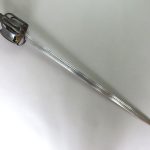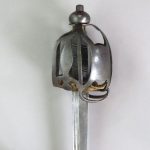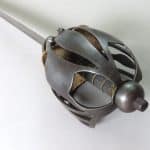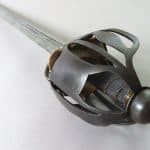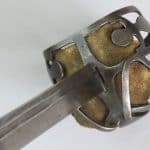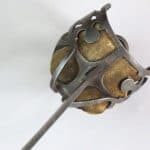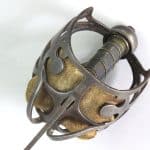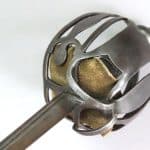
A British Basket Hilted Cavalry Back Sword Circa 1740 to 1755 with Maker’s Mark “SG” & Ordnance Inspection Mark
To enquire about this itemplease click here
Price: £2,850
Ref: 42502510
Item Description
A representative example of a British army basket hilted back sword issued to cavalry and infantry regiments in the middle of the 18th century. The sword is in fine original condition.
The basket guard is forged from broad flattened iron bars with squared edges. The hilt structure consists of a knuckle bow to the front and two side guard bars which curve upwards from the cross piece and join a ring which extends around the pommel base. Below, the frontal loop guard bars are a downward continuation of the side guard bars which loop forward to join the base of the knuckle bow at the front quillon terminal.
To the front, in the spaces between the baluster shaped knuckle bow and the two side guard bars, two saltire bars are centred with large vertically rectangular guard plates with convex rounded tops and concave sides. To the back, a rear guard bar on each side extends upwards and curves towards the top of the side guard bar which it joins near the pommel. Between the rear and side guard bars baluster shaped panels are attached with merlons at the base which strengthen the structure. The capital letters “S G” are stamped underneath the rear quillon. These most likely represent the hilt maker rather than the regimental store number which is most usually stamped onto the pommel or knucklebow.
The pommel is of typical British 18th century military bun shape with a short thick neck which fits tightly into the guard arm ring. It has a prominently raised integral round section button on top. The slightly baluster shaped grip is of oval section and spirally grooved with a shagreen cover, plus twisted brass wire binding and brass ferrules mounted top and bottom. The hilt retains its leather liner.
The single edged tapering blade is 33.75 inches (just under 86 cm) long. It has a short ricasso and a double fuller which runs underneath the squared back edge for 25.5 inches (65 cm). An Ordnance inspection mark consisting of a crown with a number 6 below is stamped near to the hilt. The blade is of high quality, most probably made in Germany and imported by the British Ordnance for the manufacture of this sword in a batch.
Swords of this type were purchased by regimental colonels for their troops. The series of paintings by David Morier housed in the Royal Collection of British cavalry and infantry uniforms and weapons give an interesting insight into the variety of basket hilted swords employed by the army in the mid 18th century bound by a common design theme. One shows a Private in The Royal Horse Guards (The Blues) dating to circa 1751 to 1760 armed with a similar sword to ours with solid side guard plates (Collection Reference RCIN 401505). Another painting by Morier entitled “An Incident in the Rebellion of 1745” shows hand-to-hand combat between Scottish Jacobite Highlanders and a line of Privates of a Grenadier company of The 4th King’s Own (Barrel’s) Regiment, with a Sergeant, an Officer and Drummer nearby (Collection Reference RCIN 401243). The soldiers carry swords which are variants of the same theme.
The grip and hilt furnishings are in fine condition. The iron hilt has a russet patination all over. The steel blade is brighter with minor speckled age. There is an old crack in the rear guard bar on one side.
The sword is almost identical to one illustrated in “The Swords and the Sorrows”, National Trust for Scotland, 1996, page 148, Fig 1:51. See also another near identical sword in Cyril Mazansky, “British Basket-Hilted Swords, The Boydell Press, 2005, page 95, Fig: F1a.

